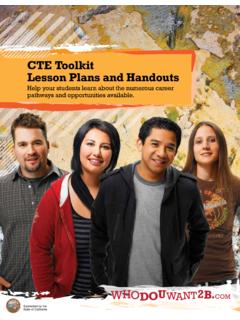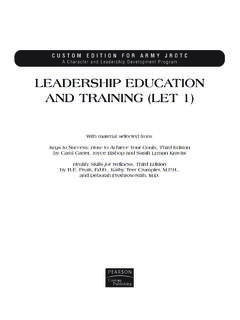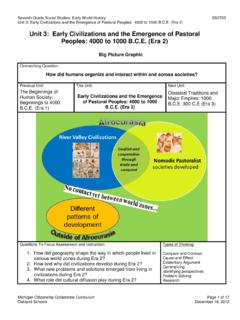Transcription of Career Exploration Lesson Plan 2.3 - Weebly
1 Page | 1 Take Charge Today August 2013 Career Exploration Funded by a grant from Take Charge America, Inc. to the Norton School of Family and Consumer Sciences Take Charge America Institute at The University of Arizona RECOMMENDED GRADE LEVELS AVERAGE TIME TO COMPLETE EACH Lesson plan IS DESIGNED AND CONTINUALLY EVALUATED BY EDUCATORS, FOR EDUCATORS. THANK YOU TO THE FOLLOWING EDUCATORS FOR DEVELOPING COMPONENTS OF THIS Lesson plan . 10 12 Anticipatory Set & Facilitation: 90 minutes Conclusion/Assessment Options: 30 75 minutes Time does not include the vocabulary activity or potential modifications. None available NATIONAL STANDARDS Lesson plan OBJECTIVES The curriculum is aligned to the following national standards: National Standards for Financial Literacy American Association of Family and Consumer Sciences Council for Economic Education National Business Education National Jump$tart Coalition Common Core English Language Arts Upon completion of this Lesson , participants will be able to.
2 Prioritize potential occupations based upon results of a Career assessment Research potential occupations Assess if the characteristics of an occupation will support high well being Assess higher education preparation needs Develop a short term Career goal and a long term Career goal MATERIALS MATERIALS PROVIDED IN THIS Lesson plan MATERIALS SPECIFIC TO THIS Lesson plan BUT AVAILABLE AS A SEPARATE DOWNLOAD MATERIALS TO ACQUIRE SEPARATELY DEPENDING ON OPTIONS TAUGHT Introduction to Occupations Occupation Characteristics Occupation Research Self Reflection Group Sharing Occupation Research Presentations Occupation Perceptions Educator Support Career Exploration Information Sheet Occupation Perceptions Career Explorations Note Taking Guide Earning Unit Multiple Choice Test Bank and Answer Key & C1 Internet access Career Exploration Advanced Level | 2 Take Charge Today August 2013 Career Exploration Funded by a grant from Take Charge America, Inc.
3 To the Norton School of Family and Consumer Sciences Take Charge America Institute at The University of Arizona RESOURCES EXTERNAL RESOURCES External resources referenced in this Lesson plan : Bureau of Labor Statistic s Occupational Outlook Handbook: My Next Move: Ice Road Truckers: road truckers Deadliest Catch: catch Alaska: The Last Frontier: shows/alaska the last frontier Swamp People: people TAKE CHARGE TODAY RESOURCES Similar Lesson plan at a different level: What Does Your Future Hold? Optional Lesson plan resources: Vocabulary Reinforcement Activities Active Learning Tool Tablet Applications for the Personal Finance Classroom Active Learning Tool Technology Integration Options Active Learning Tool The Bee Movie Active Learning Tool CONTENT EDUCATOR MATERIALS PARTICIPANT READING Materials to support educators when preparing to teach this Lesson plan are available on the Take Charge Today website.
4 Career Exploration Information Sheet OPTIONAL ADVANCE INSTRUCTIONThis Lesson is designed to be taught as a stand alone Lesson . However, background content knowledge from the following Lesson plans is directly related to this Lesson and may be helpful for participants. Invest in Yourself Lesson plan Lesson FACILITATION PREPARE Visual indicators to help prepare the Lesson INSTRUCTI nstructions to conduct the Lesson facilitation CUSTOMIZEP otential modifications to Lesson facilitation VOCABULARY ACTIVITY There is no new vocabulary for this Lesson . For a comprehensive list of all vocabulary in the Earning Unit and reinforcement activities go to Vocabulary Reinforcement Activities Active Learning Tool ANTICIPATORY SET Occupation Perceptions Approximate time: 15 minutes Materials to prepare: Occupation Perceptions per participant Occupation Perceptions Educator Support Page | 3 Take Charge Today August 2013 Career Exploration Funded by a grant from Take Charge America, Inc.
5 To the Norton School of Family and Consumer Sciences Take Charge America Institute at The University of Arizona 1. Pass out an Occupation Perceptions to each participant. 2. Conduct charades. a. Ask for four volunteers to be the actors. Provide each actor with an occupation. Examples include: i. Accountant ii. Plumber iii. Lawyer iv. Automotive mechanic b. Explain that charades is an activity in which players guess a word or phrase from silent clues being acted out by a person. Explain that the actors will be giving silent clues about characteristics of different occupations. The job of the audience is to guess the occupation described by the actor. 3. Once each occupation has been correctly guessed have participants complete the following on Occupation Perceptions a. Record the occupation. b.
6 In the first column record the characteristics of the occupation the actor used during charades. c. In the first column, also record characteristics they think of regarding the occupation. i. For example, with the occupation accountant, participants might record: 1. Sitting at a desk all day 2. Not personable 3. Writing very small with a pencil 4. Must be good with numbers 5. Wearing a suit/tie or dress/high heels 4. Repeat until all four occupations have been completed. 5. Use the Occupation Perceptions Educator Support to give participants answers about the occupation in the profile section of their Occupation Perceptions worksheet. 6. Discuss the participants findings. a. If additional information is needed, the Occupation Perceptions Educator Support is provided with additional perceptions for each occupation to use as discussion starters as well as did you know information regarding each occupation, to stress the importance of researching occupations.
7 B. Did they learn anything new about the occupation that contradicted their initial perceptions? 7. Discuss the value of research. a. Individuals may have perceptions about occupations that aren t always correct. It is important to conduct research regarding an occupation before pursuing or dismissing the potential of an occupation. RECOMMENDED FACILITATION Career Exploration Approximate time: 75 minutes Skip charades and instead state the occupation. Ask participants to record what they think of when they hear that occupation in the first column of Occupation Perceptions Conduct Pictionary instead of charades by having participants draw the occupation. Page | 4 Take Charge Today August 2013 Career Exploration Funded by a grant from Take Charge America, Inc. to the Norton School of Family and Consumer Sciences Take Charge America Institute at The University of Arizona Part 1: 15 minutes, Part 2: 45 minutes, Part 3: 15 minutes Materials to prepare: Part 1: Career Exploration information sheet per participant Career Exploration Note Taking Guide per participant Part 2: Identify a Career Assessment Tool (such as one offered by your school or My Next Move) Introduction to Occupations per participant Access to the Bureau of Labor Statistics Occupational Outlook Handbook Part 3: Occupation Characteristics per participant Because this is a project based Lesson plan with a participant led facilitation, a PowerPoint Presentation is not available.
8 Part 1: Career Exploration Note Taking Guide 1. Provide each participant with a Career Exploration information sheet and a Career Exploration Note Taking Guide 2. Instruct participants to complete the Career Exploration Note Taking Guide while reading the Career Exploration information sheet. 3. Once everyone has completed their Career Exploration Note Taking Guide , divide participants into groups of 2 3. 4. Have participants discuss the Career Exploration process by comparing what they felt was important about each section of the text and how it applies to them individually. Part 2: Introduction to Occupations 5. Display the quote Choose a job you ll love and you will never have to work a day in your life Confucius. 6. Ask participants to share what this means to them. a. When an individual carefully identifies potential occupations by completing a Career assessment they are learning about how their skills, abilities, interests, values, and/or other traits may fit with those occupations 7.
9 Have participants complete a Career assessment (a tool that suggests careers that match an individual s interests and training) available in your educational environment. a. An example of a free online tool is My Next Move (created for the Department of Labor). 8. Have participants record their potential occupations and characteristics of each occupation on the Introduction to Occupations a. If the Career assessment used did not include occupation characteristics in the results, have participants use the Occupational Outlook Handbook on the Bureau of Labor Statistics website, or another valid source. Part 3: Occupation Characteristics 9. Explain that each occupation has different characteristics and determining if If time is limited, skip Introduction to Occupations and have participants choose one occupation from their Career assessment to research in the Lesson conclusion.
10 Skip the Career assessment if participants know what occupations interest them. Page | 5 Take Charge Today August 2013 Career Exploration Funded by a grant from Take Charge America, Inc. to the Norton School of Family and Consumer Sciences Take Charge America Institute at The University of Arizona an occupation is a good fit for an individual is dependent on their values. For example, one person may desire a flexible schedule and another may care more about the amount of training required. Therefore, it is important to rank each aspect of an occupation to determine what is most important. a. Optional: Illustrate this point by showing a video clip from one of the following television shows: i. Ice Road Truckers on the History channel ii. Deadliest Catch on the Discovery channel iii. Alaska: The Last Frontier on the Discovery channel iv.







